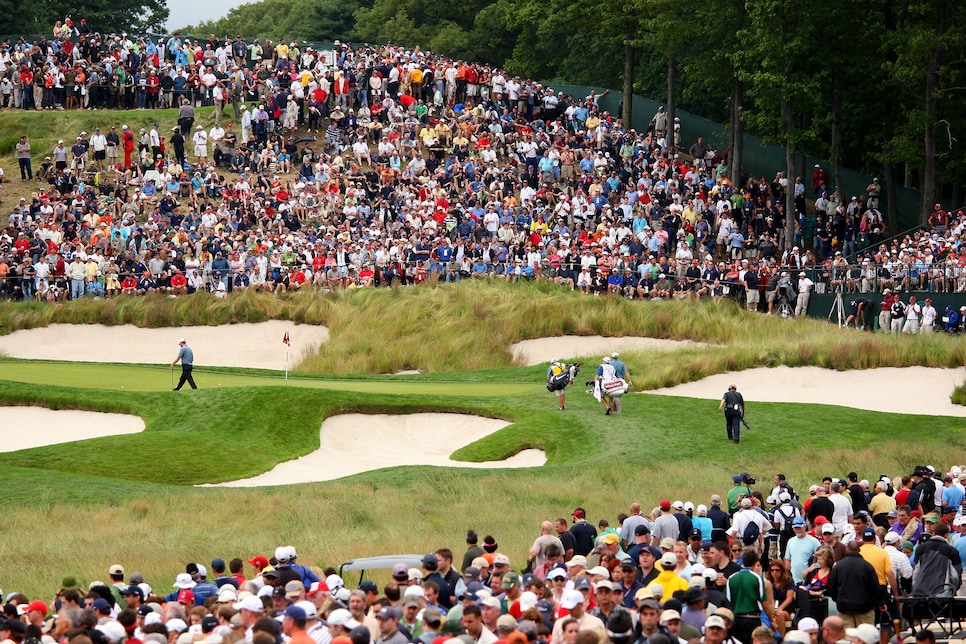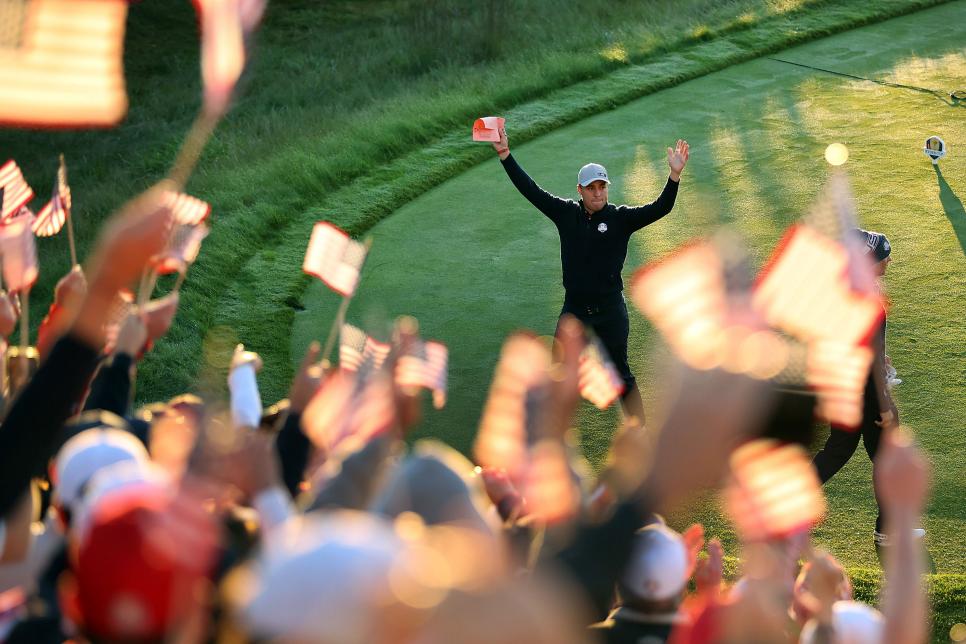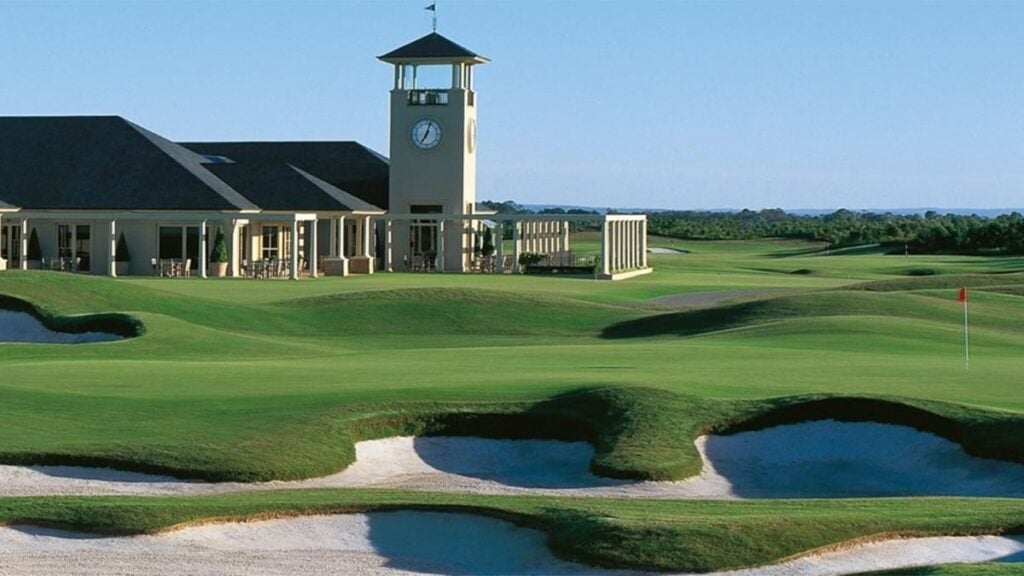[Photo: Golf Digest]
Decency surrendered on the final day. For three-and-a-half days the crowds at Bethpage Black had been subdued, a byproduct of Brooks Koepka turning the 2019 PGA Championship into a personal showcase. His seven-shot 36-hole advantage remained after 54 holes, but a series of miscues within a 40-minute span during the final round trimmed that lead to just two when Kopeka reached the short par-3 14th. Not long after his 8-iron airmailed the green a curious chant rose from the grandstands:
WATCH: LIV golfers were asked what’s the strangest app on their phone – and some of their answers were REALLY(!) strange
“Dee-Jay! Dee-Jay! Dee-Jay!”
The noise erupted organically, a recognition that Dustin Johnson, Koepka’s closest pursuer, was now within reach. Koepka’s ensuing pitch from behind the green sailed long and his par putt died short. Galleries have never had the closest rapport with Koepka, but until that moment they had given the respect Koepka’s performance had demanded. But fans are ultimately slaves to drama—particularly when that drama comes via collapse—and what was in the air was too intoxicating to ignore …
“DEEEE-JAYYY! DEEEE-JAYYY!! DEEEE-JAYYY!!!”
While owner of golf’s most unflappable poker face, Koepka couldn’t mask his incredulity and indignation as he left the 14th green. Later that evening, with the retrospection of a champion, he would reframe the hostility: “When they started chanting ‘DJ’ on 14, it actually kind of helped, to be honest with you. I think it helped me refocus and hit a good one down 15. That was probably the best thing that could have happened.” He would go on to win his fourth major in a little more than two years by two shots despite a closing 74.
Yet what provided the perfect context to the atmosphere at Bethpage Black that afternoon involved neither Koepka nor Johnson but a fan of Harold Varner III. Varner, paired with Koepka in the final group, had become a bystander after a disastrous front nine. Varner’s follower, sensing the commotion crackling through the property, seized the opportunity to duck inside the ropes as the final group descended the 14th green’s hill toward Round Swamp Road, the asphalt artery that bisects Bethpage’s first hole and final four from the rest of the course. As those chants failed to fade, the fan made a crack to no one in particularly that managed to rise above the 50,000 voices baying for blood.
“If they are doing this to Brooks,” he said, “what the hell are they going to do to Europe?”
The Ryder Cup thrives on chaos—controlled, communal chaos. Players abandon their typical reserve, pumping fists skyward or cupping ears to the crowd. Spectators are singing taunts and chanting anthems. The result is golf’s most electric atmosphere, where the sport briefly abandons its country-club sensibilities for something closer to a football game. One of 2023’s most indelible moments wasn’t a drive or approach or putt but thousands of voices serenading Patrick Cantlay about his conspicuous lack of headwear. It’s precisely this collective spirit that made the PGA of America unbending in its desire to delay a year the 2020 match at Whistling Straits in the wake of the COVID-19 pandemic despite the DP World Tour’s insistence on playing as scheduled: Without roaring crowds, what’s the point of the Ryder Cup?
That is the Ryder Cup at its most actualised. At the same time, there’s a shadow never far from the spotlight. One that in combination with being at Bethpage—a municipal course beloved by its local Long Islanders and where officials are expecting up to 50,000 fans a day—fosters one of the prevailing questions heading into next week’s match: Will the chaos get out of control?
There is precedent. Many point to the “War by the Shore” in 1991 as marking the Ryder Cup’s loss of innocence, when the collective spirit curdled into something uglier. Since then, American venues have earned a particularly harsh reputation for crossing lines in ways that, while other sports would consider routine, golf finds unacceptable.
At Hazeltine National in 2016, fans crooned Rory McIlroy with “Sweet Caroline”—a cruel reference to his former relationship with Caroline Wozniacki. The same year, Danny Willett endured a weekend of relentless heckling after his brother’s satirical article painted American fans as boorish. The Masters champion spent three days absorbing unfunny, mean-spirited abuse that had nothing to do with his golf game.

Rory McIlroy reacts to crowds rooting against him and the European team during the 2016 Ryder Cup at Hazeltine.Ramsey Cardy/Getty Images
The 2021 Ryder Cup at Whistling Straits offered a brief reprieve. COVID restrictions kept the crowds thin while the course’s rugged topography kept fans at a respectful distance. Lake Michigan’s winds muffled whatever chants emerged. It felt like a return to sanity, although a sanity that might not survive Bethpage Black.
PGA of America officials haven’t forgotten what they witnessed at Bethpage’s previous major championships. If New York crowds tormented Koepka, what awaits foreign opponents? History suggests the worst. At the 2002 US Open, fans taunted Sergio García with “Waggle Boy” chants, counting his regrips on his pre-shot routine. The 2009 championship saw Padraig Harrington booed for a missed flop shot, and the USGA cut alcohol sales early on the weekend due to fan misconduct.
This isn’t isolated to Bethpage; it’s a New York phenomenon. The city’s sports culture prides itself on being unforgiving, on its teams or their opponents. At the 2017 Presidents Cup, lopsided American victories only emboldened Liberty National crowds to savage the International team. The 2018 US Open at Shinnecock Hills descended into brief madness, with fans cheering wayward European shots and chanting “USA!” in Ian Poulter’s face after a bogey.
“Verbally abused on every hole does get a little old,” Poulter wrote afterward. “That’s not really golf either. Ryder Cup in 2024 COULD become a little silly, just like today was.”
Poulter identified a core problem then that applies particularly to the Ryder Cup: premier golf events have non-golf crowds. In attendance are sports fans who happen to be watching golf, mixing genuine spectators with spectacle-seekers who view heckling as entertainment. When nationalism enters the equation like it does with the Ryder Cup, some fans confuse xenophobia and jingoism for patriotism.

If it’s time hosting past majors, including the 2009 U.S. Open, is a guide, the fans won’t be shy letting their feelings be heard.Andrew Redington
Which leads into the LIV Golf element. This September will mark the first major New York golf event since the Saudi-backed league shattered the professional game’s unity. Though the civil war has mostly cooled down, the LIV controversy takes on particular resonance in the shadow of Manhattan, where the September attacks remain an open wound. Fifteen of the 19 hijackers were Saudi nationals, and families of victims continue pursuing legal accountability from the kingdom for possible connections to the event.
We already have proof of concept of what awaits LIV players: In upstate New York at Oak Hill in 2023, LIV players Koepka and Bryson DeChambeau faced sustained booing. DeChambeau, who qualified for this year’s American team, has since rehabilitated his image with casual fans, but Bethpage crowds will likely prove less forgiving to European team members Jon Rahm and Tyrrell Hatton, whose Saudi connections won’t go unnoticed by galleries already primed for confrontation.
There’s also the broader crisis of deteriorating gallery behavior. Higher alcohol consumption, gambling, escalating ticket prices and attention-seeking culture have become a toxic mix. Fan misconduct isn’t unique to golf, but the sport’s disruptions carry power. A solitary voice cutting through tournament silence can be as disruptive as entire sections chanting in unison, and recent evidence suggests an alarming escalation. This year alone, Rory McIlroy endured heckling at both the Genesis Invitational and Players Championship, the latter causing him to confiscate a fan’s phone. Rickie Fowler—golf’s most fan-friendly figure—was captured lashing out at a spectator after enduring grandstand taunts. The WM Phoenix Open implemented new restrictions after 2024’s event devolved into player-fan confrontations and spectator brawls. Even Brian Harman’s hostile reception at the 2023 Open Championship proves this issue transcends American borders.
Add it up, and the week at Bethpage sets up to be a potential powder keg. So what can be done to keep it from exploding?

Europe’s Tyrrell Hatton tried to win over American fans in 2021 at Whistling Straits by tossing out cheeseheads.Warren Little
American captain Keegan Bradley acknowledges the delicate balance his team must strike. “We certainly don’t want the fans to affect the play of a player by yelling in their backswing or doing something inappropriate,” he says. “We would never want that. Having said that, it’s going be a very difficult place to play, just like Rome was for the Americans. That’s what you want as a home team. That’s why you go to a place like Bethpage, where the fans are part of the course’s DNA. The Europeans know that. We know that as Americans, they’re going be tough on us as well. We need to perform and win for them, and that is the focus.”
The PGA of America isn’t relying on hope. PGA of America officials wouldn’t detail specific security plans, however, sources familiar with tournament planning confirm significantly increased security measures are in place for this Ryder Cup. Beyond uniformed officers, plain clothes police will circulate throughout galleries. A zero-tolerance policy will target aggressive behaviour toward players, with particular attention to actions involving families. Several players, including McIlroy, will have dedicated security details.
“We fully expect the spectators to be loud, passionate and respectful toward both teams,” says Ryder Cup director Bryan Karns. “In coordination with New York State Police, we will have a multi-layered security plan in place to help ensure a positive experience for all involved. As in the past, in the handful of instances where there is an issue, our operations staff and security team will address it quickly.”

American players will have to walk a fine line when interacting with the home crowds, trying to get them loud but not have them spin out of control.Warren Little
President Donald Trump’s expected attendance during the first competition day on Friday’s first sessions further complicates matters. Secret Service coordination with federal and local agencies means additional enforcement presence, heightened by recent security concerns following the murder of conservative influencer Charlie Kirk.
“We don’t wait for these incidents,” New York State Police Maj. Steve Udice told local news outlets during a public meeting at Farmingdale Village Hall earlier this month. “We have intelligence units who are constantly monitoring social media. You’re going to see a heavy uniformed presence—but what you’re not going to see is the heavy non-uniformed presence.”
Internal opinions among some at the PGA of America remain divided. Veterans of Bethpage’s 2019 PGA Championship and previous Ryder Cups fear history’s repetition. Optimists point to 2021’s improved atmosphere as evidence of progress. Even the controversial ticket pricing generates debate. Some believe prices approaching $US1,000 per day will exclude rowdier elements seeking only alcoholic entertainment. Others worry the cost will attract Wall Street crowds known for excessive celebration.
The Europeans aren’t taking chances—they’re using VR headsets to simulate the coming abuse. It’s smart preparation that’s also deeply unfortunate. At its finest, the Ryder Cup transforms golf’s solitary pursuit into something beautifully communal, where passion coexists with respect for opponents and the game itself. The event has always walked a razor’s edge between raw emotion and civility. At Bethpage, that edge cuts across terrain already cracked and unstable, with 50,000 spectators holding the power to determine which way the event falls.
Perhaps it’s fitting this unfolds at a course famous for its “Warning” sign on the first tee. Only this time, the caution should be aimed at the galleries. It’s an alert that shouldn’t need stating, but silence won’t quiet the coming storm.



